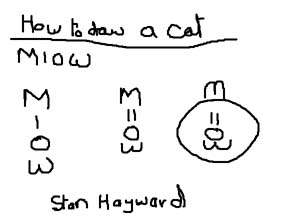
Nearly a hundred years ago, Thomas Edison the great inventor envisaged film being used in schools as a teaching aid; it didn't happen, at least not in his lifetime.
The term 'Visual Literacy' was coined in the 1960s, and coincided with the rapid development of Advertising in its various forms.
The term 'Visual Literacy' was coined in the 1960s, and coincided with the rapid development of Advertising in its various forms.
At the time I remember there was a great enthusiasm for technology about to solve all the worlds problems - particularly education. Single-Concept 8mm films would allow students to teach themselves; Audio-cassettes took over the language learning field, and Microfilm enabled you to have a library in your pocket.
Most of the equipment ended up in school cupboards unused because they were more bother than they were worth. Teachers like teaching, not setting up equipment so students can teach themselves; while students are often unmotivated for self-instruction.
My own opinion is that it needs a generation brought up on images before Visual Literacy can really take off. My generation (pre-war) had comics like the Beano and Dandy, and there were several illustrated magazines like 'Everybody's' around, but newspapers of the time had few photographs, and none in colour.
Children of the 1960s were in their twenties before personal computers were commonly around, and even those born in 1980s hasn't given a full generation of computer literates.
Visual Literacy suffers from an identity problem; comics, photo-mags, advertising, and the like are the most commonly quoted examples. But this is because 'Writing' is a core subject in schools while drawing/photography isn't.
Today's Blog is inspired by the fact that Google has just released its Literacy project:
http://www.google.com/literacy/ link which appears not to include Visual Literacy as far as I can see.
A good site to start with is the following one, aimed at Primary schools.
http://k-8visual.info/
My main interest is to teach Storyboarding as an introduction to movie making. The Wiki link
http://en.wikipedia.org/wiki/Storyboard explains the basis of it.
But storyboards can be used for just about any form of planning. I noticed one being used for a bank robbery in a movie.
Check out: Visual Literacy
Stan
Most of the equipment ended up in school cupboards unused because they were more bother than they were worth. Teachers like teaching, not setting up equipment so students can teach themselves; while students are often unmotivated for self-instruction.
My own opinion is that it needs a generation brought up on images before Visual Literacy can really take off. My generation (pre-war) had comics like the Beano and Dandy, and there were several illustrated magazines like 'Everybody's' around, but newspapers of the time had few photographs, and none in colour.
Children of the 1960s were in their twenties before personal computers were commonly around, and even those born in 1980s hasn't given a full generation of computer literates.
Visual Literacy suffers from an identity problem; comics, photo-mags, advertising, and the like are the most commonly quoted examples. But this is because 'Writing' is a core subject in schools while drawing/photography isn't.
Today's Blog is inspired by the fact that Google has just released its Literacy project:
http://www.google.com/literacy/ link which appears not to include Visual Literacy as far as I can see.
A good site to start with is the following one, aimed at Primary schools.
http://k-8visual.info/
My main interest is to teach Storyboarding as an introduction to movie making. The Wiki link
http://en.wikipedia.org/wiki/Storyboard explains the basis of it.
But storyboards can be used for just about any form of planning. I noticed one being used for a bank robbery in a movie.
Check out: Visual Literacy
Stan

